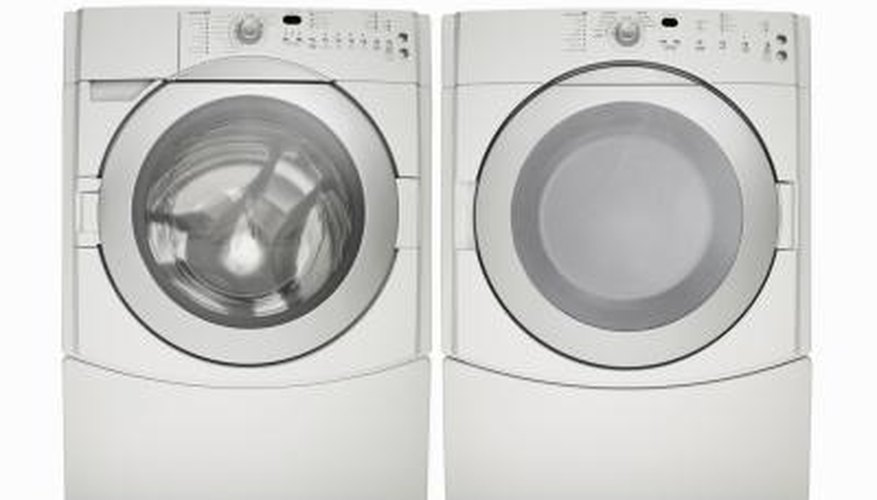Washers and dryers come in various sizes and combinations. Determining the amount of room needed around the washer and dryer requires several measurements to get the right fit. Measuring the planned space helps to determine the overall space available. Measuring each unit helps to verify the allowable sizes. Combined, these measurements will tell you how much space you need per machine.
Size Requirements
Compare the overall exterior dimensions of the washer and dryer to the interior dimensions of the space they are intended for. You want the machines to fit snug in the space while still allowing gaps large enough to manoeuvre and for airflow once installed. Both washers and dryers give off heat that needs to circulate away from the machine. Check the width of the machines, front to back, to ensure they do not cut off or limit pathways around them. Place a laundry basket in front of the machine width-wise to help gauge space and accessibility between the front of the machine and any opposing wall.
- Compare the overall exterior dimensions of the washer and dryer to the interior dimensions of the space they are intended for.
- Place a laundry basket in front of the machine width-wise to help gauge space and accessibility between the front of the machine and any opposing wall.
Headroom
Determine the amount of headroom required over the washer and dryer. Headroom is the amount of space above the machines. Installing cabinets above the washer and dryer requires enough space between the top of the machines and the bottom of the cabinetry. Usually the distance from the floor to the bottom of the cabinet is approximately 56 inches, which allows enough room to open the lid to a top-loading machine.
- Determine the amount of headroom required over the washer and dryer.
- Installing cabinets above the washer and dryer requires enough space between the top of the machines and the bottom of the cabinetry.
Vents
Read the manufacturer's booklet to determine the minimum space allowances at the rear of the machines. Both gas and electric units require space behind the machines to allow for vents, cords and plugs. This space can measure from a few inches (for electrical sockets) to 1 foot (for vents and hoses in gas units). Add this space allowance to the overall width of the machine when determining placement. Washers and dryers are usually 30 inches wide without any allowance for cords or vents.
- Read the manufacturer's booklet to determine the minimum space allowances at the rear of the machines.
- Both gas and electric units require space behind the machines to allow for vents, cords and plugs.
Combination Units
Factor in the size and shape of the machines. Using a compact combination unit takes up less width sideways and front to back but doubles the height requirement. According to CNET Reviews, the average height for stackable units is 33 inches whereas the height for combination units doubles to 66 inches. Add space at the front of any compact units to allow for the front door to swing freely. Compact units are smaller than regular size machines, so the workload allowed is reduced; if you use a full-size machine and a compact machine in tandem, this must be considered in regards to storage or overloading. Overall size can vary up to 16 inches between manufacturers.
- Factor in the size and shape of the machines.
- Compact units are smaller than regular size machines, so the workload allowed is reduced; if you use a full-size machine and a compact machine in tandem, this must be considered in regards to storage or overloading.
